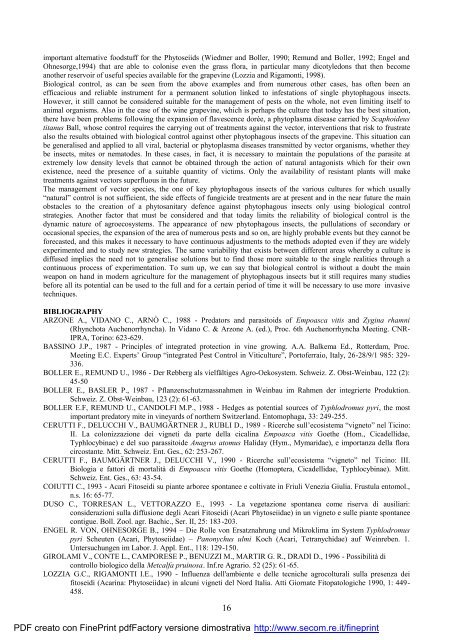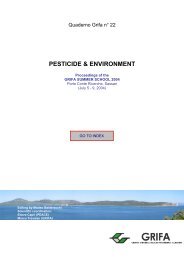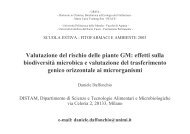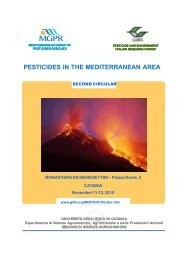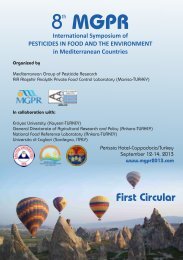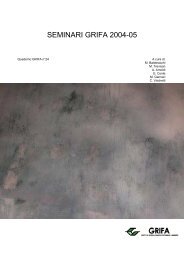International Congress BIOLOGICAL PRODUCTS - Gruppo di ...
International Congress BIOLOGICAL PRODUCTS - Gruppo di ...
International Congress BIOLOGICAL PRODUCTS - Gruppo di ...
Create successful ePaper yourself
Turn your PDF publications into a flip-book with our unique Google optimized e-Paper software.
important alternative foodstuff for the Phytoseiids (Wiedmer and Boller, 1990; Remund and Boller, 1992; Engel and<br />
Ohnesorge,1994) that are able to colonise even the grass flora, in particular many <strong>di</strong>cotyledons that then become<br />
another reservoir of useful species available for the grapevine (Lozzia and Rigamonti, 1998).<br />
Biological control, as can be seen from the above examples and from numerous other cases, has often been an<br />
efficacious and reliable instrument for a permanent solution linked to infestations of single phytophagous insects.<br />
However, it still cannot be considered suitable for the management of pests on the whole, not even limiting itself to<br />
animal organisms. Also in the case of the wine grapevine, which is perhaps the culture that today has the best situation,<br />
there have been problems following the expansion of flavescence dorée, a phytoplasma <strong>di</strong>sease carried by Scaphoideus<br />
titanus Ball, whose control requires the carrying out of treatments against the vector, interventions that risk to frustrate<br />
also the results obtained with biological control against other phytophagous insects of the grapevine. This situation can<br />
be generalised and applied to all viral, bacterial or phytoplasma <strong>di</strong>seases transmitted by vector organisms, whether they<br />
be insects, mites or nematodes. In these cases, in fact, it is necessary to maintain the populations of the parasite at<br />
extremely low density levels that cannot be obtained through the action of natural antagonists which for their own<br />
existence, need the presence of a suitable quantity of victims. Only the availability of resistant plants will make<br />
treatments against vectors superfluous in the future.<br />
The management of vector species, the one of key phytophagous insects of the various cultures for which usually<br />
“natural” control is not sufficient, the side effects of fungicide treatments are at present and in the near future the main<br />
obstacles to the creation of a phytosanitary defence against phytophagous insects only using biological control<br />
strategies. Another factor that must be considered and that today limits the reliability of biological control is the<br />
dynamic nature of agroecosystems. The appearance of new phytophagous insects, the pullulations of secondary or<br />
occasional species, the expansion of the area of numerous pests and so on, are highly probable events but they cannot be<br />
forecasted, and this makes it necessary to have continuous adjustments to the methods adopted even if they are widely<br />
experimented and to study new strategies. The same variability that exists between <strong>di</strong>fferent areas whereby a culture is<br />
<strong>di</strong>ffused implies the need not to generalise solutions but to find those more suitable to the single realities through a<br />
continuous process of experimentation. To sum up, we can say that biological control is without a doubt the main<br />
weapon on hand in modern agriculture for the management of phytophagous insects but it still requires many stu<strong>di</strong>es<br />
before all its potential can be used to the full and for a certain period of time it will be necessary to use more invasive<br />
techniques.<br />
BIBLIOGRAPHY<br />
ARZONE A., VIDANO C., ARNÒ C., 1988 - Predators and parasitoids of Empoasca vitis and Zygina rhamni<br />
(Rhynchota Auchenorrhyncha). In Vidano C. & Arzone A. (ed.), Proc. 6th Auchenorrhyncha Meeting. CNR-<br />
IPRA, Torino: 623-629.<br />
BASSINO J.P., 1987 - Principles of integrated protection in vine growing. A.A. Balkema Ed., Rotterdam, Proc.<br />
Meeting E.C. Experts’ Group “integrated Pest Control in Viticulture”, Portoferraio, Italy, 26-28/9/1 985: 329-<br />
336.<br />
BOLLER E., REMUND U., 1986 - Der Rebberg als vielfältiges Agro-Oekosystem. Schweiz. Z. Obst-Weinbau, 122 (2):<br />
45-50<br />
BOLLER E., BASLER P., 1987 - Pflanzenschutzmassnahmen in Weinbau im Rahmen der integrierte Produktion.<br />
Schweiz. Z. Obst-Weinbau, 123 (2): 61-63.<br />
BOLLER E.F, REMUND U., CANDOLFI M.P., 1988 - Hedges as potential sources of Typhlodromus pyri, the most<br />
important predatory mite in vineyards of northern Switzerland. Entomophaga, 33: 249-255.<br />
CERUTTI F., DELUCCHI V., BAUMGÄRTNER J., RUBLI D., 1989 - Ricerche sull’ecosistema “vigneto” nel Ticino:<br />
II. La colonizzazione dei vigneti da parte della cicalina Empoasca vitis Goethe (Hom., Cicadellidae,<br />
Typhlocybinae) e del suo parassitoide Anagrus atomus Haliday (Hym., Mymaridae), e importanza della flora<br />
circostante. Mitt. Schweiz. Ent. Ges., 62: 253-267.<br />
CERUTTI F., BAUMGÄRTNER J., DELUCCHI V., 1990 - Ricerche sull’ecosistema “vigneto” nel Ticino: III.<br />
Biologia e fattori <strong>di</strong> mortalità <strong>di</strong> Empoasca vitis Goethe (Homoptera, Cicadellidae, Typhlocybinae). Mitt.<br />
Schweiz. Ent. Ges., 63: 43-54.<br />
COIUTTI C., 1993 - Acari Fitosei<strong>di</strong> su piante arboree spontanee e coltivate in Friuli Venezia Giulia. Frustula entomol.,<br />
n.s. 16: 65-77.<br />
DUSO C., TORRESAN L., VETTORAZZO E., 1993 - La vegetazione spontanea come riserva <strong>di</strong> ausiliari:<br />
considerazioni sulla <strong>di</strong>ffusione degli Acari Fitosei<strong>di</strong> (Acari Phytoseiidae) in un vigneto e sulle piante spontanee<br />
contigue. Boll. Zool. agr. Bachic., Ser. II, 25: 183-203.<br />
ENGEL R. VON, OHNESORGE B., 1994 – Die Rolle von Ersatznahrung und Mikroklima im System Typhlodromus<br />
pyri Scheuten (Acari, Phytoseiidae) – Panonychus ulmi Koch (Acari, Tetranychidae) auf Weinreben. 1.<br />
Untersuchungen im Labor. J. Appl. Ent., 118: 129-150.<br />
GIROLAMI V., CONTE L., CAMPORESE P., BENUZZI M., MARTIR G. R., DRADI D., 1996 - Possibilità <strong>di</strong><br />
controllo biologico della Metcalfa pruinosa. Inf.re Agrario. 52 (25): 61-65.<br />
LOZZIA G.C., RIGAMONTI I.E., 1990 - Influenza dell'ambiente e delle tecniche agrocolturali sulla presenza dei<br />
fitosei<strong>di</strong> (Acarina: Phytoseiidae) in alcuni vigneti del Nord Italia. Atti Giornate Fitopatologiche 1990, 1: 449-<br />
458.<br />
PDF creato con FinePrint pdfFactory versione <strong>di</strong>mostrativa http://www.secom.re.it/fineprint<br />
16


